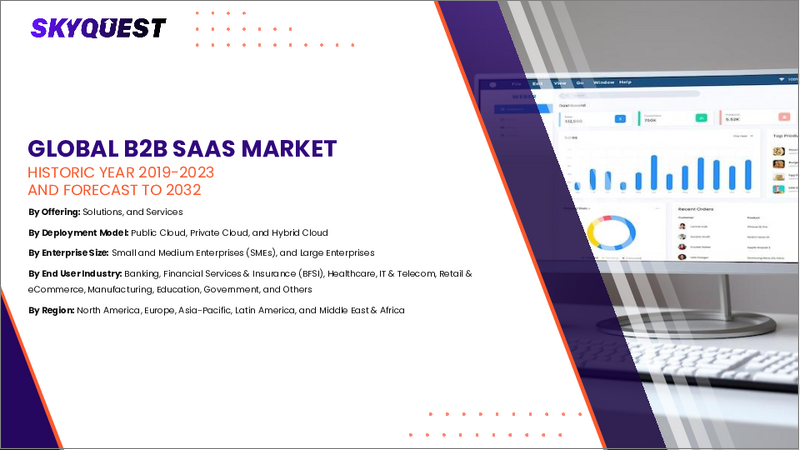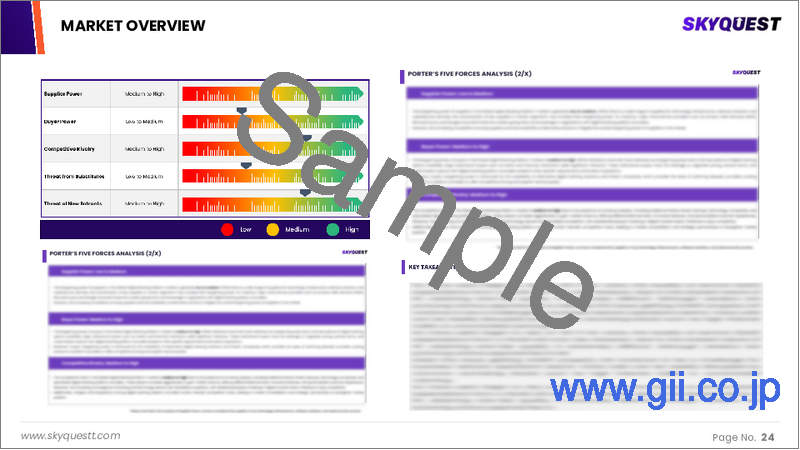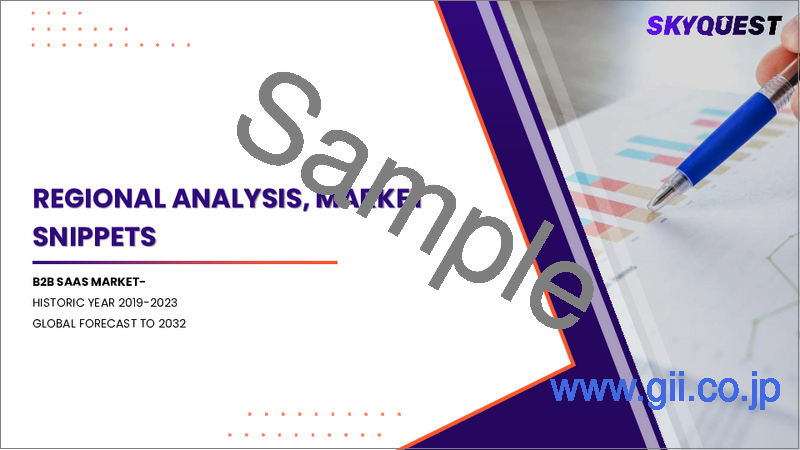|
|
市場調査レポート
商品コード
1738082
B2B SaaS市場規模、シェア、成長分析、ソフトウェアタイプ別、展開タイプ別、アプリケーション別、企業タイプ別、業界別、地域別 - 産業予測 2025年~2032年B2B SaaS Market Size, Share, and Growth Analysis, By Software Type (Enterprise Resource Planning, Customer Relationship Management), By Deployment Type, By Application, By Enterprise Type, By Industry, By Region - Industry Forecast 2025-2032 |
||||||
|
|||||||
| B2B SaaS市場規模、シェア、成長分析、ソフトウェアタイプ別、展開タイプ別、アプリケーション別、企業タイプ別、業界別、地域別 - 産業予測 2025年~2032年 |
|
出版日: 2025年05月27日
発行: SkyQuest
ページ情報: 英文 194 Pages
納期: 3~5営業日
|
全表示
- 概要
- 目次
B2B SaaSの世界市場規模は、2023年に3,286億米ドルと評価され、2024年の3,930億1,000万米ドルから2032年には1兆6,453億1,000万米ドルに成長し、予測期間中(2025年~2032年)のCAGRは19.6%で成長する見通しです。
デジタル化は世界のビジネス範囲に革命をもたらし、技術の進歩によって新たな市場機会を生み出しています。スマートフォンの普及は極めて重要で、遠隔地でもインターネットにアクセスできるようになり、これによって企業はB2B eコマースに従事できるようになりました。このアクセスのしやすさが迅速で効率的な取引を促進し、B2Bプラットフォームをますます魅力的なものにしています。同時に、B2B SaaS市場は急速に進化しており、企業は業務効率の向上とITコストの削減のため、従来のソフトウェアモデルよりもクラウドベースのソリューションを好んで利用しています。この変革は、経済成長とデジタルの導入が急増しているアジア太平洋地域で特に顕著です。中国のような国々はこのデジタルシフトの最前線にあり、インターネットユーザーの増加とデジタルテクノロジーへの傾倒の高まりが、B2B eコマースソリューションの需要を後押ししています。
目次
イントロダクション
- 調査の目的
- 調査範囲
- 定義
調査手法
- 情報調達
- 二次と一次データの方法
- 市場規模予測
- 市場の前提条件と制限
エグゼクティブサマリー
- 世界市場の見通し
- 供給と需要の動向分析
- セグメント別機会分析
市場力学と見通し
- 市場概要
- 市場規模
- 市場力学
- 促進要因と機会
- 抑制要因と課題
- ポーターの分析
主な市場の考察
- 重要成功要因
- 競合の程度
- 主な投資機会
- 市場エコシステム
- 市場の魅力指数(2024年)
- PESTEL分析
- マクロ経済指標
- バリューチェーン分析
- 価格分析
B2B SaaS市場規模:ソフトウェアタイプ別& CAGR(2025-2032)
- 市場概要
- エンタープライズリソースプランニング(ERP)
- 顧客関係管理(CRM)
- 人材管理(HCM)
- サプライチェーンマネジメント(SCM)
- その他
B2B SaaS市場規模:展開タイプ別& CAGR(2025-2032)
- 市場概要
- パブリック
- プライベート
- ハイブリッド
B2B SaaS市場規模:アプリケーション別& CAGR(2025-2032)
- 市場概要
- 顧客関係管理(CRM)
- エンタープライズリソースプランニング(ERP)
- コンテンツ、コラボレーション、コミュニケーション
- BIと分析
- 人材管理
- その他
B2B SaaS市場規模:企業タイプ別& CAGR(2025-2032)
- 市場概要
- 大企業
- 中小企業
B2B SaaS市場規模:業界別& CAGR(2025-2032)
- ITおよび通信
- BFSI
- 小売・消費財
- ヘルスケア
- 教育
- 製造業
- その他(旅行・ホスピタリティ)
B2B SaaS市場規模:地域別& CAGR(2025-2032)
- 北米
- 米国
- カナダ
- 欧州
- ドイツ
- スペイン
- フランス
- 英国
- イタリア
- その他欧州地域
- アジア太平洋地域
- 中国
- インド
- 日本
- 韓国
- その他アジア太平洋地域
- ラテンアメリカ
- ブラジル
- その他ラテンアメリカ地域
- 中東・アフリカ
- GCC諸国
- 南アフリカ
- その他中東・アフリカ
競合情報
- 上位5社の比較
- 主要企業の市場ポジショニング(2024年)
- 主な市場企業が採用した戦略
- 最近の市場動向
- 企業の市場シェア分析(2024年)
- 主要企業の企業プロファイル
- 企業の詳細
- 製品ポートフォリオ分析
- 企業のセグメント別シェア分析
- 収益の前年比比較(2022-2024年)
主要企業プロファイル
- Microsoft(USA)
- Salesforce(USA)
- Adobe(USA)
- Oracle(USA)
- SAP(Germany)
- ServiceNow(USA)
- Shopify(Canada)
- Atlassian(Australia)
- Intuit(USA)
- Workday(USA)
- Google(USA)
- HubSpot(USA)
- Zoom(USA)
- Datadog(USA)
- CrowdStrike(USA)
- Autodesk(USA)
- Snowflake(USA)
- DocuSign(USA)
- Veeva Systems(USA)
- Asana(USA)
結論と提言
Global B2B SaaS Market size was valued at USD 328.6 billion in 2023 and is poised to grow from USD 393.01 billion in 2024 to USD 1645.31 billion by 2032, growing at a CAGR of 19.6% during the forecast period (2025-2032).
Digitalization is revolutionizing global business reach, creating new market opportunities driven by technological advancements. The growing penetration of smartphones is pivotal, enhancing internet access even in remote areas, which enables businesses to engage in B2B e-commerce. This accessibility fosters quick and efficient transactions, making B2B platforms increasingly attractive. Concurrently, the B2B SaaS market is evolving rapidly, with businesses favoring cloud-based solutions over traditional software models to improve operational efficiency and lower IT costs. This transformation is particularly pronounced in the Asia Pacific region, where economic growth and digital adoption are surging. Countries like China are at the forefront of this digital shift, with rising internet users and a growing inclination towards digital technologies propelling the demand for B2B e-commerce solutions.
Top-down and bottom-up approaches were used to estimate and validate the size of the Global B2B SaaS market and to estimate the size of various other dependent submarkets. The research methodology used to estimate the market size includes the following details: The key players in the market were identified through secondary research, and their market shares in the respective regions were determined through primary and secondary research. This entire procedure includes the study of the annual and financial reports of the top market players and extensive interviews for key insights from industry leaders such as CEOs, VPs, directors, and marketing executives. All percentage shares split, and breakdowns were determined using secondary sources and verified through Primary sources. All possible parameters that affect the markets covered in this research study have been accounted for, viewed in extensive detail, verified through primary research, and analyzed to get the final quantitative and qualitative data.
Global B2B SaaS Market Segments Analysis
Global B2B SaaS Market is segmented by Software Type, Deployment Type, Application, Enterprise Type, Industry and region. Based on Software Type, the market is segmented into Enterprise Resource Planning (ERP), Customer Relationship Management (CRM), Human Capital Management (HCM), Supply Chain Management (SCM) and Others. Based on Deployment Type, the market is segmented into Public, Private and Hybrid. Based on Application, the market is segmented into Customer Relationship Management (CRM), Enterprise Resource Planning (ERP), Content, Collaboration, and Communication, BI and Analytics, Human Capital Management and Others. Based on Enterprise Type, the market is segmented into Large Enterprises, SMEs, By Industry, IT and Telecom, BFSI, Retail and Consumer Goods, Healthcare, Education, Manufacturing and Others (Travel and Hospitality). Based on Industry, the market is segmented into IT and Telecom, BFSI, Retail and Consumer Goods, Healthcare, Education, Manufacturing, Others (Travel and Hospitality). Based on region, the market is segmented into North America, Europe, Asia Pacific, Latin America and Middle East & Africa.
Driver of the Global B2B SaaS Market
The transformation brought about by the growing prevalence of remote and hybrid work is reshaping business operations on a global scale. Organizations now rely heavily on cloud-based software solutions for essential functions like communication, collaboration, project management, and overall productivity. Applications such as Microsoft Teams, Zoom, and Trello have become indispensable for ensuring business continuity in this new landscape. Consequently, even the most traditional companies are fast-tracking their digital transformation efforts, leading to significant adoption of B2B SaaS solutions across various industries. These tools not only enhance operational efficiency but also enable businesses to foster flexible work arrangements and broaden their talent acquisition strategies across different regions.
Restraints in the Global B2B SaaS Market
Although there have been significant advancements in cloud technology, many businesses still exhibit reluctance to store sensitive data in third-party environments due to various concerns. Issues such as data breaches, unauthorized access, and the need to comply with stringent regulations-including GDPR, HIPAA, and CCPA-pose major obstacles, particularly for industries like healthcare, legal, and finance. Consequently, even top-tier SaaS providers are required to continuously enhance their security measures, perform regular audits, and obtain necessary certifications to instill confidence among their enterprise clients. This cautious attitude towards data privacy and security remains a substantial constraint within the global B2B SaaS market.
Market Trends of the Global B2B SaaS Market
The Global B2B SaaS market is experiencing a transformative shift as Artificial Intelligence (AI) evolves from a differentiator to an essential element of software offerings. By 2024, major players like Salesforce and HubSpot have integrated AI features such as embedded assistants, which streamline operations by automating repetitive tasks and facilitating more profound data analysis. This trend includes the rise of AI-driven chatbots, predictive lead scoring, and automated content creation, which have become baseline requirements for customer-centric applications. As businesses increasingly rely on these AI capabilities, they're optimizing their sales, marketing, and support functions, significantly enhancing overall operational efficiency and decision-making.
Table of Contents
Introduction
- Objectives of the Study
- Scope of the Report
- Definitions
Research Methodology
- Information Procurement
- Secondary & Primary Data Methods
- Market Size Estimation
- Market Assumptions & Limitations
Executive Summary
- Global Market Outlook
- Supply & Demand Trend Analysis
- Segmental Opportunity Analysis
Market Dynamics & Outlook
- Market Overview
- Market Size
- Market Dynamics
- Drivers & Opportunities
- Restraints & Challenges
- Porters Analysis
- Competitive rivalry
- Threat of substitute
- Bargaining power of buyers
- Threat of new entrants
- Bargaining power of suppliers
Key Market Insights
- Key Success Factors
- Degree of Competition
- Top Investment Pockets
- Market Ecosystem
- Market Attractiveness Index, 2024
- PESTEL Analysis
- Macro-Economic Indicators
- Value Chain Analysis
- Pricing Analysis
Global B2B SaaS Market Size by Software Type & CAGR (2025-2032)
- Market Overview
- Enterprise Resource Planning (ERP)
- Customer Relationship Management (CRM)
- Human Capital Management (HCM)
- Supply Chain Management (SCM)
- Others
Global B2B SaaS Market Size by Deployment Type & CAGR (2025-2032)
- Market Overview
- Public
- Private
- Hybrid
Global B2B SaaS Market Size by Application & CAGR (2025-2032)
- Market Overview
- Customer Relationship Management (CRM)
- Enterprise Resource Planning (ERP)
- Content, Collaboration, and Communication
- BI and Analytics
- Human Capital Management
- Others
Global B2B SaaS Market Size by Enterprise Type & CAGR (2025-2032)
- Market Overview
- Large Enterprises
- SMEs
Global B2B SaaS Market Size By Industry & CAGR (2025-2032)
- IT and Telecom
- BFSI
- Retail and Consumer Goods
- Healthcare
- Education
- Manufacturing
- Others (Travel and Hospitality)
Global B2B SaaS Market Size & CAGR (2025-2032)
- North America (Software Type, Deployment Type, Application, Enterprise Type)
- US
- Canada
- Europe (Software Type, Deployment Type, Application, Enterprise Type)
- Germany
- Spain
- France
- UK
- Italy
- Rest of Europe
- Asia Pacific (Software Type, Deployment Type, Application, Enterprise Type)
- China
- India
- Japan
- South Korea
- Rest of Asia-Pacific
- Latin America (Software Type, Deployment Type, Application, Enterprise Type)
- Brazil
- Rest of Latin America
- Middle East & Africa (Software Type, Deployment Type, Application, Enterprise Type)
- GCC Countries
- South Africa
- Rest of Middle East & Africa
Competitive Intelligence
- Top 5 Player Comparison
- Market Positioning of Key Players, 2024
- Strategies Adopted by Key Market Players
- Recent Developments in the Market
- Company Market Share Analysis, 2024
- Company Profiles of All Key Players
- Company Details
- Product Portfolio Analysis
- Company's Segmental Share Analysis
- Revenue Y-O-Y Comparison (2022-2024)
Key Company Profiles
- Microsoft (USA)
- Company Overview
- Business Segment Overview
- Financial Updates
- Key Developments
- Salesforce (USA)
- Company Overview
- Business Segment Overview
- Financial Updates
- Key Developments
- Adobe (USA)
- Company Overview
- Business Segment Overview
- Financial Updates
- Key Developments
- Oracle (USA)
- Company Overview
- Business Segment Overview
- Financial Updates
- Key Developments
- SAP (Germany)
- Company Overview
- Business Segment Overview
- Financial Updates
- Key Developments
- ServiceNow (USA)
- Company Overview
- Business Segment Overview
- Financial Updates
- Key Developments
- Shopify (Canada)
- Company Overview
- Business Segment Overview
- Financial Updates
- Key Developments
- Atlassian (Australia)
- Company Overview
- Business Segment Overview
- Financial Updates
- Key Developments
- Intuit (USA)
- Company Overview
- Business Segment Overview
- Financial Updates
- Key Developments
- Workday (USA)
- Company Overview
- Business Segment Overview
- Financial Updates
- Key Developments
- Google (USA)
- Company Overview
- Business Segment Overview
- Financial Updates
- Key Developments
- HubSpot (USA)
- Company Overview
- Business Segment Overview
- Financial Updates
- Key Developments
- Zoom (USA)
- Company Overview
- Business Segment Overview
- Financial Updates
- Key Developments
- Datadog (USA)
- Company Overview
- Business Segment Overview
- Financial Updates
- Key Developments
- CrowdStrike (USA)
- Company Overview
- Business Segment Overview
- Financial Updates
- Key Developments
- Autodesk (USA)
- Company Overview
- Business Segment Overview
- Financial Updates
- Key Developments
- Snowflake (USA)
- Company Overview
- Business Segment Overview
- Financial Updates
- Key Developments
- DocuSign (USA)
- Company Overview
- Business Segment Overview
- Financial Updates
- Key Developments
- Veeva Systems (USA)
- Company Overview
- Business Segment Overview
- Financial Updates
- Key Developments
- Asana (USA)
- Company Overview
- Business Segment Overview
- Financial Updates
- Key Developments





